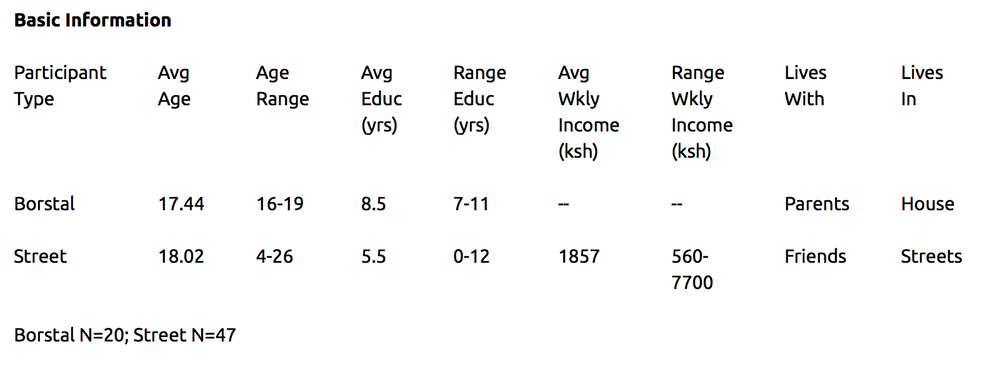Growing Up is Hard
Growing up is hard. It’s especially hard if you’re living on the streets in Mombasa, or if your misbehavior in your community led to your short-term imprisonment in a correctional facility. These are the children with which we work through the MotoMoto program. Although the children and youth from the streets and the youth from the correctional facility have very different pasts and experiences, they are still responding to our methodology in similarly positive ways.
Who They Are
The table below contains a summary of basic characteristics of MotoMoto participants separated by type of participant (from the streets or from the Borstal). The average age is very similar, around 18 years old. All the children in the Borstal are male by necessity, but most of the children (all but 2) from the streets are also male. However, those in the Borstal have much more education than those in the streets, having completed at least primary school on average. Prior to entering the Borstal, most of these boys were also living with and being supported by their parents. Those children from the streets, in contrast, were living without parents and supporting themselves primarily by begging, hustling, and garbage collection.

What They Need
These different life experiences have led the youth from the streets and those from the Borstal to have very different needs. Those in the Borstal often need help with psycho-emotional issues and pursuing further education. Addressing psycho-emotional issues and facilitating access to future education will ensure they can reintegrate with their families and pursue meaningful employment after their incarceration. In contrast, the children from the streets most often cite substance abuse treatment and employment skills as key needs, seeking practical skills to maintain themselves on the streets.
In response to these unique needs, our life skills counselor has focused on providing psycho-emotional tools to deal with these differing challenges. In the Borstal, we focus on teaching self-awareness and positive decision-making skills, so youth, who were mostly incarcerated for petty theft and under-aged sex, can identify their emotional state and make good decisions despite how they feel. On the streets, we focus on why youth use drugs, how it affects them, and how to stop.
How They’ve Progressed
On the streets, the youth population is unstable and transitory, they disappear for months only to return and resume training with the Poi and life skills. For that reason, even though the Borstal sessions were added later, those boys have attended almost as many sessions as those on the streets. Not surprisingly, the boys from the Borstal are also rapidly catching up in terms of their Poi skill level, with most being intermediate level (like the street youth) in common tricks like helicopter, weave, and backward weave. Both the Borstal boys and the street children have a meaningful understanding of life skills related to identifying common needs and challenges facing themselves (and youth in general), as well as self-esteem and decision-making. Some of the street youth are already engaging in behavior change, stopping their drug use during class, at least. Further, some in the Borstal are actively expressing more positive attitudes toward themselves and their futures.



